Conditional GAN for FCAL Shower generation#
%pip install h5py scikit-learn torch torchvision tqdm safetensors autograd torchmetrics > /dev/null
Note: you may need to restart the kernel to use updated packages.
import os
from urllib.parse import urlparse
import urllib.request
from tqdm import tqdm
class DownloadProgressBar(tqdm):
"""Custom TQDM progress bar for urllib downloads."""
def update_to(self, blocks=1, block_size=1, total_size=None):
"""
Update the progress bar.
Args:
blocks (int): Number of blocks transferred so far.
block_size (int): Size of each block (in bytes).
total_size (int, optional): Total size of the file (in bytes).
"""
if total_size is not None:
self.total = total_size
self.update(blocks * block_size - self.n)
def download(url, target_dir):
"""
Download a file from a URL into the target directory with progress display.
Args:
url (str): Direct URL to the file.
target_dir (str): Directory to save the file.
Returns:
str: Path to the downloaded (or existing) file.
"""
# Ensure the target directory exists
os.makedirs(target_dir, exist_ok=True)
# Infer the filename from the URL
filename = os.path.basename(urlparse(url).path)
local_path = os.path.join(target_dir, filename)
# If file already exists, skip download
if os.path.exists(local_path):
print(f"✅ File already exists: {local_path}")
return local_path
# Download with progress bar
print(f"⬇️ Downloading {filename} from {url}")
with DownloadProgressBar(unit='B', unit_scale=True, miniters=1, desc=filename) as t:
urllib.request.urlretrieve(url, filename=local_path, reporthook=t.update_to)
print(f"✅ Download complete: {local_path}")
return local_path
dataset_url = "https://huggingface.co/datasets/AI4EIC/DNP2025-tutorial/resolve/main/formatted_dataset/CNN4FCAL_GUN_PATCHSIZE_11.h5"
data_dir = "data"
dataset_path = download(dataset_url, data_dir)
✅ File already exists: data/CNN4FCAL_GUN_PATCHSIZE_11.h5
Note
This is exactly the same as in CNN for Regression.
We are using the same .h5 dataset for regression. when we process it, We will be simply selecting out photons only to perform our training
Step 1: Open and Inspect the .h5 File#
We can open the dataset and confirm whats inside it
import h5py, numpy as np
with h5py.File(dataset_path, "r") as f:
print("✅ Datasets available:", list(f.keys()))
print("🔍 patches shape:", f["patches"].shape)
print("🔍 labels shape:", f["label"].shape)
✅ Datasets available: ['label', 'patches', 'showerE', 'thrownE']
🔍 patches shape: (814151, 11, 11)
🔍 labels shape: (814151,)
Step 2: Create a Custom PyTorch Dataset#
This dataset will:
Read directly from the
.h5fileOptionally we can apply normalization in the form of transformation
import torch
from torch.utils.data import Dataset, DataLoader
import numpy as np # Import numpy
class FCALPatchPhotonDataset(Dataset):
def __init__(self, h5_path, indices=None, transform=None, thrownNormalize=True, minthrownE = 0.1, maxthrownE = 4.0):
"""
Parameters
----------
h5_path : str
Path to the HDF5 file.
indices : list or np.ndarray, optional
Subset of indices to use (for train/val/test split).
transform : callable, optional
Optional transform to apply to each patch.
"""
# Open the file handle here and keep it open
self.h5_path = h5_path
self.file = h5py.File(self.h5_path, "r")
self.indices = indices
self.transform = transform
self.minthrownE = minthrownE # GeV
self.maxthrownE = maxthrownE # GeV
# Assign datasets directly from the file handle
self.length = len(self.file["label"])
self.labels = np.array(self.file["label"], dtype=np.int64)
self.labels = self.labels[self.indices if self.indices is not None else slice(None)]
self.patches = np.array(self.file["patches"], dtype=np.float32)
self.patches = self.patches[self.indices] if self.indices is not None else self.patches
self.showerE = np.array(self.file["showerE"], dtype=np.float32)
self.showerE = self.showerE[self.indices if self.indices is not None else slice(None)]
self.thrownE = np.array(self.file["thrownE"], dtype=np.float32)
self.thrownE = self.thrownE[self.indices if self.indices is not None else slice(None)]
self.file.close()
# lets select only photons and select photons only with showerE >= 1 <= 2
self.photon_indices = np.where((self.labels == 1) & (self.thrownE >= self.minthrownE) & (self.thrownE <= self.maxthrownE))
self.length = len(self.photon_indices)
self.labels = self.labels[self.photon_indices]
self.patches = self.patches[self.photon_indices]
self.showerE = self.showerE[self.photon_indices]
self.thrownE = self.thrownE[self.photon_indices]
if thrownNormalize:
self.thrownE = ( self.thrownE - self.minthrownE ) / ( self.maxthrownE - self.minthrownE ) # Normalize
def __len__(self):
return len(self.labels)
def __getitem__(self, idx):
# Handle subset indices
# Access data directly from the assigned attributes
patch = self.patches[idx]
label = self.labels[idx]
showerE = self.showerE[idx]
thrownE = self.thrownE[idx]
# Optional transform
if self.transform:
patch = self.transform(patch)
# Convert to torch tensors
patch = torch.from_numpy(patch).unsqueeze(0) # (1, 11, 11)
return patch, label, showerE, thrownE
Step 3: Create Dataset and DataLoader Objects#
The entire dataset will be used for training here. Let us normalize each of the images with the total energy of all the hits in the shower
MIN_THROWN_E = 1.0 # GeV
MAX_THROWN_E = 2.0 # GeV
ENERGY_SCALE = 0.05 # GeV (for global log scaling)
MIN_ENERGY_THRESH = 0.05 # GeV We will not retain pixels with energy less than this
CLIP_MAX = 2.0 # GeV per cell clamp for scaling
DEVICE = "cuda" if torch.cuda.is_available() else "cpu"
USE_AMP = (DEVICE == "cuda") # automatic mixed precision only on CUDA
BATCH_SIZE = 512
NUM_WORKERS = 1
pin = (DEVICE == "cuda")
def log_global_norm(W, e0=ENERGY_SCALE, emax=CLIP_MAX):
# Keep everything float32 to avoid silent upcasts to float64
W = W.clip(min=0).astype(np.float32, copy=False)
e0 = np.float32(e0)
emax = np.float32(emax)
Z = np.log1p(W / e0).astype(np.float32, copy=False)
Z /= np.log1p(emax / e0).astype(np.float32, copy=False)
np.clip(Z, 0.0, 1.0, out=Z)
Z = 2.0 * Z - 1.0 # now in [-1,1]
return Z # float32
def inv_log_global_norm(Z, e0=ENERGY_SCALE, emax=CLIP_MAX):
# Z in [-1, 1] -> W in GeV
Z01 = (Z + 1.0) / 2.0
return e0 * np.expm1(Z01 * np.log1p(emax / e0))
def inv_log_global_norm_torch(Z, e0=ENERGY_SCALE, emax=CLIP_MAX):
# Z in [-1, 1] -> W in GeV
Z01 = (Z + 1.0) / 2.0
e0_t = torch.as_tensor(e0, dtype=Z01.dtype, device=Z01.device)
emax_t = torch.as_tensor(emax, dtype=Z01.dtype, device=Z01.device)
return e0_t * torch.expm1(Z01 * torch.log1p(emax_t / e0_t))
def normalize_patch(patch):
# Example normalization to total energy = 1
total = np.sum(patch)
return patch / total if total > 0 else patch
train_ds = FCALPatchPhotonDataset(dataset_path,transform=log_global_norm, minthrownE=MIN_THROWN_E, maxthrownE=MAX_THROWN_E)
train_loader = DataLoader(train_ds, batch_size=BATCH_SIZE, shuffle=True
)
len(train_ds), len(train_loader)
(113758, 223)
# lets check a few samples
patches, labels, showerE, thrownE = next(iter(train_loader))
print("Batch shape:", patches.shape) # (B, 1, 11, 11)
print("Labels:", labels[:8])
print("showerE:", showerE[:8])
print("thrownE:", thrownE[:8])
# Lets visualize a few patches
import matplotlib.pyplot as plt
import numpy as np
fig, axes = plt.subplots(2, 4, figsize=(12, 6))
for i, ax in enumerate(axes.flat):
ax.matshow(patches[i, 0].numpy(), cmap='viridis', origin='lower')
thE = thrownE[i].item() * (MAX_THROWN_E - MIN_THROWN_E) + MIN_THROWN_E
ax.set_title(f'ShowerE: {showerE[i].item():.2f} GeV\n ThrownE: {thE:.2f} GeV')
#ax.axis('off')
plt.tight_layout()
plt.show()
Batch shape: torch.Size([512, 1, 11, 11])
Labels: tensor([1, 1, 1, 1, 1, 1, 1, 1])
showerE: tensor([1.1265, 1.7753, 1.8933, 1.1213, 1.8121, 0.8762, 1.4885, 1.5860])
thrownE: tensor([0.1288, 0.5836, 0.8712, 0.1819, 0.8454, 0.0968, 0.6243, 0.5636])
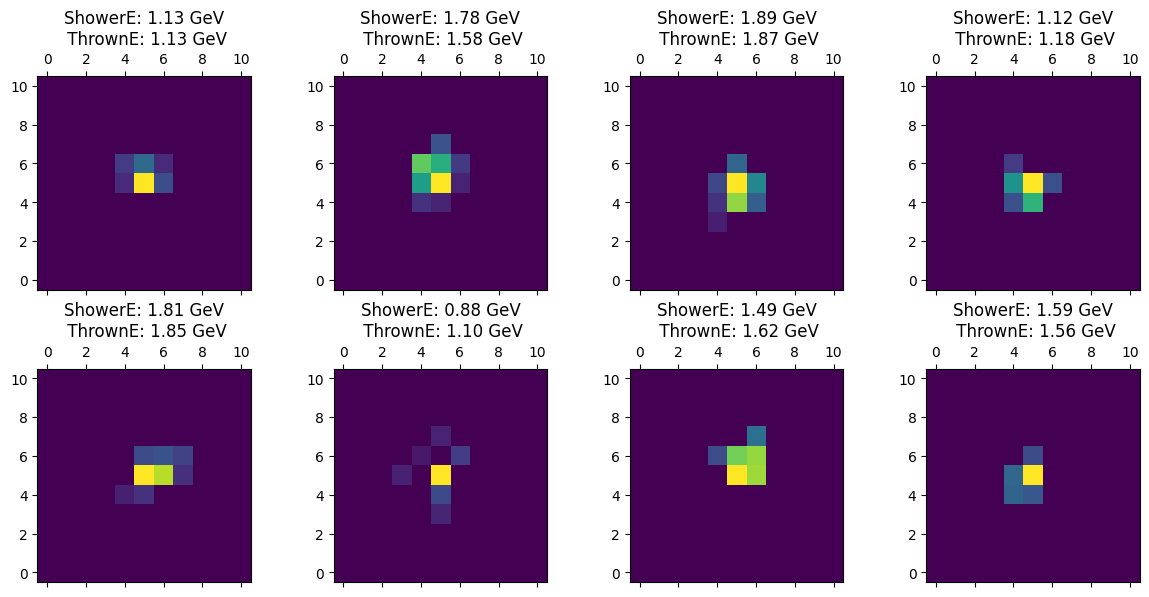
Step 4: Diagnostic plots#
Let us make a few diagnostic plots. We will be using these plots for visual comparison between generated samples and true distributions.
def compute_patch_metrics(patches: torch.Tensor, thrownE: torch.Tensor, patch_size = 11, e_threshold = MIN_ENERGY_THRESH) -> dict:
"""
Compute metrics for a batch of patches.
Parameters
----------
patches : torch.Tensor
Tensor of shape (B, 1, 11, 11) representing the patches.
thrownE : torch.Tensor
Tensor of shape (B,) representing the thrown energies.
Returns
-------
dict
Dictionary containing numHits, rows, cols, energies, total energy (sum), max cell energy, E1/E9 ratio, E9/E25 ratio, and energy-weighted centroid for each patch.
"""
B = patches.shape[0]
assert patches.shape == (B, 1, patch_size, patch_size)
assert thrownE.shape == (B,)
# Remove channel dimension
patches = patches.squeeze(1) # (B, 11, 11)
# Number of hits (cells with energy > 0.05 GeV)
patches = patches * (patches > e_threshold) # Zero out cells below threshold
numHits = (patches > 0).sum(dim=(1, 2)) # (B,)
# Row and column indices of hits
_, rows, cols = torch.nonzero(patches > 0, as_tuple=True) # (N_hits,), (N_hits,)
hit_batch_indices = rows // patch_size # Determine which batch each hit belongs to
rows = rows % patch_size
cols = cols % patch_size
# Energies of hits
energies = patches[patches > 0] # (N_hits,)
# Total energy in each patch
total_energy = patches.sum(dim=(1, 2)) # (B,)
# Max cell energy in each patch
max_cell_energy, _ = patches.view(B, -1).max(dim=1) # (B,)
# E1/E9 ratio
e1 = max_cell_energy # (B,)
e9 = torch.zeros(B, device=patches.device) # (B,)
for b in range(B):
if numHits[b] > 0:
max_idx = torch.argmax(patches[b])
r, c = divmod(max_idx.item(), patch_size)
r_min = max(r - 1, 0)
r_max = min(r + 2, patch_size)
c_min = max(c - 1, 0)
c_max = min(c + 2, patch_size)
e9[b] = patches[b, r_min:r_max, c_min:c_max].sum()
e1_e9_ratio = e1 / e9.clamp(min=1e-6) # Avoid division by zero
# E9/E25 ratio
e25 = torch.zeros(B, device=patches.device) # (B,)
for b in range(B):
if numHits[b] > 0:
max_idx = torch.argmax(patches[b])
r, c = divmod(max_idx.item(), patch_size)
r_min = max(r - 2, 0)
r_max = min(r + 3, patch_size)
c_min = max(c - 2, 0)
c_max = min(c + 3, patch_size)
e25[b] = patches[b, r_min:r_max, c_min:c_max].sum()
e9_e25_ratio = e9 / e25.clamp(min=1e-6) # Avoid division by zero
# Energy-weighted centroid
centroids = []
for b in range(B):
if total_energy[b] > 0:
r_indices = torch.arange(patch_size, device=patches.device).view(1, -1).expand(11, 11)
c_indices = torch.arange(patch_size, device=patches.device).view(-1, 1).expand(11, 11)
weighted_r = (patches[b] * r_indices).sum() / total_energy[b]
weighted_c = (patches[b] * c_indices).sum() / total_energy[b]
centroids.append((weighted_r.item(), weighted_c.item()))
else:
centroids.append((-1.0, -1.0)) # Indicate no hits with -1
centroids = np.array(centroids) # (B, 2)
return {
"numHits": numHits.cpu().numpy(),
"rows": rows.cpu().numpy(),
"cols": cols.cpu().numpy(),
"energies": energies.cpu().numpy(),
"total_energy": total_energy.cpu().numpy(),
"max_cell_energy": max_cell_energy.cpu().numpy(),
"e1_e9_ratio": e1_e9_ratio.cpu().numpy(),
"e9_e25_ratio": e9_e25_ratio.cpu().numpy(),
"centroids": centroids
}
def plot_patch_metrics(metrics: dict, title = "Patch Metrics", save_path = None):
import matplotlib.pyplot as plt
fig, axs = plt.subplots(4, 3, figsize=(15, 15))
axs[0, 0].hist(metrics["numHits"], bins=30, color='blue', alpha=0.7)
axs[0, 0].set_title("Number of Hits per Patch")
axs[0, 0].set_xlabel("Number of Hits")
axs[0, 0].set_ylabel("Frequency")
axs[0, 1].hist(metrics["total_energy"], bins=100, range = (0., 4.0), color='green', alpha=0.7)
axs[0, 1].set_title("Total Energy per Patch")
axs[0, 1].set_xlabel("Total Energy (GeV)")
axs[0, 1].set_ylabel("Frequency")
axs[0, 2].hist(metrics["max_cell_energy"], bins=50, range=(0., 2.0), color='red', alpha=0.7)
axs[0, 2].set_title("Max Cell Energy per Patch")
axs[0, 2].set_xlabel("Max Cell Energy (GeV)")
axs[0, 2].set_ylabel("Frequency")
axs[1, 0].hist(metrics["e1_e9_ratio"], bins=100, range=(0, 1.0),color='purple', alpha=0.7)
axs[1, 0].set_title("E1/E9 Ratio")
axs[1, 0].set_xlabel("E1/E9")
axs[1, 0].set_ylabel("Frequency")
axs[1, 1].hist(metrics["e9_e25_ratio"], bins=100, range=(0, 1.0),color='orange', alpha=0.7)
axs[1, 1].set_title("E9/E25 Ratio")
axs[1, 1].set_xlabel("E9/E25")
axs[1, 1].set_ylabel("Frequency")
# make y log scale
axs[1, 1].set_yscale('log')
centroids = metrics["centroids"]
axs[1, 2].hist(centroids[:, 0], bins=50, color='purple', alpha=0.7)
axs[1, 2].set_title("Energy-weighted Centroids (along Row)")
axs[1, 2].set_xlabel("Rows")
axs[1, 2].set_ylabel("Frequency")
axs[2, 0].hist(centroids[:, 1], bins=50, color='cyan', alpha=0.7)
axs[2, 0].set_title("Energy-weighted Centroids (along Column)")
axs[2, 0].set_xlabel("Column Index")
axs[2, 0].set_ylabel("Frequency")
axs[2, 1].hist(metrics["rows"], bins=11, range=(0, 11), color='cyan', alpha=0.7)
axs[2, 1].set_title("Hit Row Indices")
axs[2, 1].set_xlabel("Row Index")
axs[2, 1].set_ylabel("Frequency")
axs[2, 2].hist(metrics["cols"], bins=11, range=(0, 11), color='magenta', alpha=0.7)
axs[2, 2].set_title("Hit Column Indices")
axs[2, 2].set_xlabel("Column Index")
axs[2, 2].set_ylabel("Frequency")
axs[3, 0].hist(metrics["energies"], bins=200, range = (0., 2.), color='brown', alpha=0.7)
axs[3, 0].set_title("Hit Cell Energies")
axs[3, 0].set_xlabel("Cell Energy (GeV)")
axs[3, 0].set_ylabel("Frequency")
# make it log y
axs[3, 0].set_yscale('log')
# lets switch off the last two subplots
axs[3, 1].axis('off')
axs[3, 2].axis('off')
plt.suptitle(title, fontsize=16)
plt.tight_layout()
if save_path:
plt.savefig(save_path)
plt.show()
def compare_plot(generator_metrics: dict, true_patch_metrics: dict, save_path = None):
import matplotlib.pyplot as plt
fig, axs = plt.subplots(4, 3, figsize=(15, 15))
# Lets make sure the histograms are not filled but has two patterns for linestyle and color is blue and red
axs[0, 0].hist(generator_metrics["numHits"], bins=30, color='blue', alpha=0.5, histtype='step', label='Generator')
axs[0, 0].hist(true_patch_metrics["numHits"], bins=30, color='red', alpha=0.5, histtype='step', label='True Showers')
axs[0, 0].set_title("Number of Hits per Patch")
axs[0, 0].set_xlabel("Number of Hits")
axs[0, 0].set_ylabel("Frequency")
axs[0, 0].legend()
axs[0, 1].hist(generator_metrics["total_energy"], bins=100, range = (0., 4.0), color='blue', alpha=0.5, histtype='step', label='Generator')
axs[0, 1].hist(true_patch_metrics["total_energy"], bins=100, range = (0., 4.0), color='red', alpha=0.5, histtype='step', label='True Showers')
axs[0, 1].set_title("Total Energy per Patch")
axs[0, 1].set_xlabel("Total Energy (GeV)")
axs[0, 1].set_ylabel("Frequency")
axs[0, 1].legend()
axs[0, 2].hist(generator_metrics["max_cell_energy"], bins=50, range=(0., 2.0), color='blue', alpha=0.5, histtype='step', label='Generator')
axs[0, 2].hist(true_patch_metrics["max_cell_energy"], bins=50, range=(0., 2.0), color='red', alpha=0.5, histtype='step', label='True Showers')
axs[0, 2].set_title("Max Cell Energy per Patch")
axs[0, 2].set_xlabel("Max Cell Energy (GeV)")
axs[0, 2].set_ylabel("Frequency")
axs[0, 2].legend()
axs[1, 0].hist(generator_metrics["e1_e9_ratio"], bins=100, range=(0, 1.0),color='blue', alpha=0.5, histtype='step', label='Generator')
axs[1, 0].hist(true_patch_metrics["e1_e9_ratio"], bins=100, range=(0, 1.0),color='red', alpha=0.5, histtype='step', label='True Showers')
axs[1, 0].set_title("E1/E9 Ratio")
axs[1, 0].set_xlabel("E1/E9")
axs[1, 0].set_ylabel("Frequency")
axs[1, 0].legend()
axs[1, 1].hist(generator_metrics["e9_e25_ratio"], bins=100, range=(0, 1.0),color='blue', alpha=0.5, histtype='step', label='Generator')
axs[1, 1].hist(true_patch_metrics["e9_e25_ratio"], bins=100, range=(0, 1.0),color='red', alpha=0.5, histtype='step', label='True Showers')
axs[1, 1].set_title("E9/E25 Ratio")
axs[1, 1].set_xlabel("E9/E25")
axs[1, 1].set_ylabel("Frequency")
axs[1, 1].set_yscale('log')
axs[1, 1].legend()
gen_centroids = generator_metrics["centroids"]
disc_centroids = true_patch_metrics["centroids"]
axs[1, 2].hist(gen_centroids[:, 0], bins=50, color='blue', alpha=0.5, histtype='step', label='Generator')
axs[1, 2].hist(disc_centroids[:, 0], bins=50, color='red', alpha=0.5, histtype='step', label='True Showers')
axs[1, 2].set_title("Energy-weighted Centroids (along Row)")
axs[1, 2].set_xlabel("Rows")
axs[1, 2].set_ylabel("Frequency")
axs[1, 2].legend()
axs[2, 0].hist(gen_centroids[:, 1], bins=50, color='blue', alpha=0.5, histtype='step', label='Generator')
axs[2, 0].hist(disc_centroids[:, 1], bins=50, color='red', alpha=0.5, histtype='step', label='True Showers')
axs[2, 0].set_title("Energy-weighted Centroids (along Column)")
axs[2, 0].set_xlabel("Column Index")
axs[2, 0].set_ylabel("Frequency")
axs[2, 0].legend()
axs[2, 1].hist(generator_metrics["rows"], bins=11, range=(0, 11), color='blue', alpha=0.5, histtype='step', label='Generator')
axs[2, 1].hist(true_patch_metrics["rows"], bins=11, range=(0, 11), color='red', alpha=0.5, histtype='step', label='True Showers')
axs[2, 1].set_title("Hit Row Indices")
axs[2, 1].set_xlabel("Row Index")
axs[2, 1].set_ylabel("Frequency")
axs[2, 1].legend()
axs[2, 2].hist(generator_metrics["cols"], bins=11, range=(0, 11), color='blue', alpha=0.5, histtype='step', label='Generator')
axs[2, 2].hist(true_patch_metrics["cols"], bins=11, range=(0, 11), color='red', alpha=0.5, histtype='step', label='True Showers')
axs[2, 2].set_title("Hit Column Indices")
axs[2, 2].set_xlabel("Column Index")
axs[2, 2].set_ylabel("Frequency")
axs[2, 2].legend()
axs[3, 0].hist(generator_metrics["energies"], bins=200, range = (0., 2.), color='blue', alpha=0.5, histtype='step', label='Generator')
axs[3, 0].hist(true_patch_metrics["energies"], bins=200, range = (0., 2.), color='red', alpha=0.5, histtype='step', label='True Showers')
axs[3, 0].set_title("Hit Cell Energies")
axs[3, 0].set_xlabel("Cell Energy (GeV)")
axs[3, 0].set_ylabel("Frequency")
axs[3, 0].set_yscale('log')
axs[3, 0].legend()
# lets switch off the last two subplots
axs[3, 1].axis('off')
axs[3, 2].axis('off')
plt.suptitle("Generated vs True Showers Patch Metrics", fontsize=16)
plt.tight_layout()
if save_path:
plt.savefig(save_path)
plt.show()
num_samples = 10_000
# lets randomly sample 10k patches from the dataset
indices = np.random.choice(len(train_ds), size=num_samples, replace=False)
patches = torch.from_numpy(train_ds.patches[indices]).unsqueeze(1) # (N, 1, 11, 11)
thrownE = torch.from_numpy(train_ds.thrownE[indices]) # (N,)
patches_metrics = compute_patch_metrics(patches, thrownE)
plot_patch_metrics(patches_metrics)
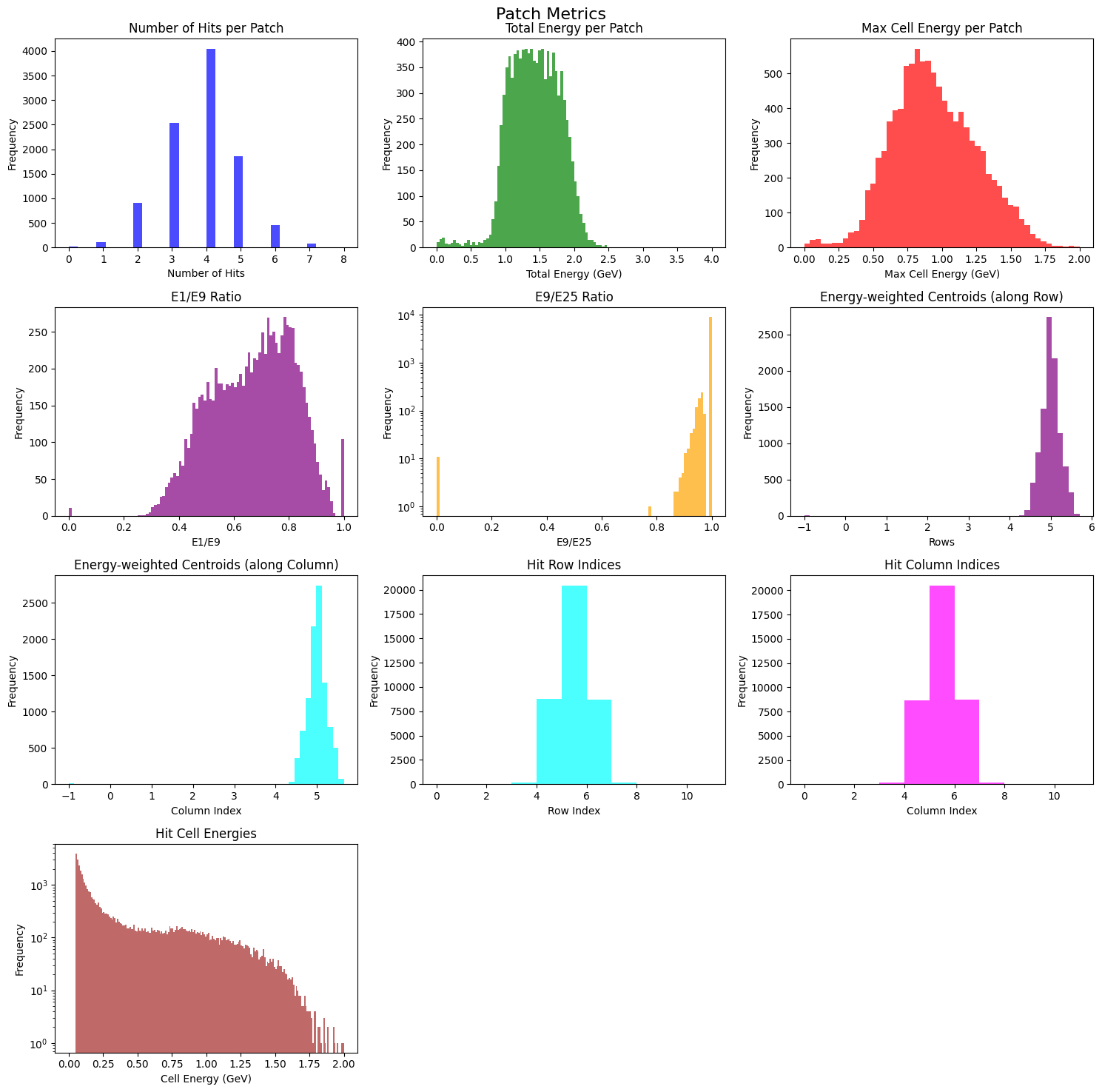
GAN architecture#
The architecture implemented here is a conditional Wasserstein GAN with Gradient Penalty (WGAN-GP), designed for fast simulation of calorimeter hit patterns conditioned on thrown particle energy. The goal is to learn a smooth mapping between the underlying particle-level features (e.g., thrown energy) and the corresponding spatial energy depositions (pixel maps) in the Forward Calorimeter.
Generator Network#
The Generator (G) learns to map a random latent vector z (sampled from a Gaussian prior) and a conditioning vector e (normalized thrown energy) into a realistic hit map of dimension 11×11. The conditioning is incorporated via Feature-wise Linear Modulation (FiLM) layers, which apply learned affine transformations to intermediate feature maps based on the conditioning input.
The FiLM layers effectively “steer” the generator’s internal activations so that the generated pattern corresponds to the desired physical energy.
Upsampling is performed progressively using bilinear interpolation followed by convolution and FiLM modulation.
The output is a single-channel calorimeter image normalized to the range [-1, 1].
This structure ensures that the generator not only learns realistic spatial correlations but also remains responsive to changes in physical conditions (energy, and later possibly \(\theta\) and \(\phi\)).
Discriminator Network#
The Discriminator (D) acts as an energy-conditioned critic. It receives both the calorimeter image and the conditioning vector, and evaluates a scalar “realness” score without a sigmoid activation — consistent with the Wasserstein formulation.
The image is passed through a sequence of spectrally normalized convolutional layers, producing compact latent representations.
The conditioning vector is embedded through a linear projection layer and combined with the image features using an inner product — a technique known as projection discrimination.
This allows the discriminator to evaluate not only the realism of the image but also its consistency with the given energy condition.
The discriminator’s score hence represents how well the generated image lies on the true data manifold for that particular physical condition.
import torch
import torch.nn as nn
from safetensors.torch import save_file
from tqdm import tqdm
import numpy as np
from contextlib import nullcontext
import autograd
# ---------------------------
# Configuration
# ---------------------------
PATCH_SIZE = 11 # or whatever your patch dimension is
COND_DIM_GEN = 1 # normalized thrownE (scalar)
COND_DIM_DISC = 1 # same conditioning dimension for projection layer
LATENT_DIM = 64
HIDDEN_CH = 64
DEVICE = "cuda" if torch.cuda.is_available() else "cpu"
LR = 2e-4
BETA1, BETA2 = 0.0, 0.9
EPOCHS = 100
USE_AMP = (DEVICE == "cuda") # automatic mixed precision only on CUDA
LAMBDA_GP = 15.0
N_CRITIC = 2 # number of D updates per G update
print (f"Using device: {DEVICE}, AMP: {USE_AMP}")
# ---------------------------
# conditional vector and random noise
# ---------------------------
def generate_latent_vector(size, latent_dim=LATENT_DIM):
return torch.randn(size, latent_dim, device=DEVICE)
def sample_condition_vector(thrownE, size):
indices = np.random.choice(len(thrownE), size, replace=False)
return thrownE[indices]
# ---------- FiLM layer ----------
class FiLM2d(nn.Module):
def __init__(self, channels, cond_dim=COND_DIM_GEN):
super().__init__()
self.to_gamma = nn.Linear(cond_dim, channels)
self.to_beta = nn.Linear(cond_dim, channels)
def forward(self, x, cond):
gamma = self.to_gamma(cond).unsqueeze(-1).unsqueeze(-1)
beta = self.to_beta(cond).unsqueeze(-1).unsqueeze(-1)
return x * (1 + gamma) + beta
# ---------- Generator (upsample+conv; no checkerboard) ----------
class Gen(nn.Module):
def __init__(self, zdim=LATENT_DIM, cdim=COND_DIM_GEN, base=HIDDEN_CH, patch=PATCH_SIZE):
super().__init__()
self.patch = patch
self.fc = nn.Sequential(
nn.Linear(zdim+cdim, base*2*2*2), nn.ReLU(True) # (B, base*2, 2, 2)
)
self.b1 = nn.Sequential(nn.Conv2d(base*2, base, 3, padding=1), nn.BatchNorm2d(base), nn.ReLU(True))
self.f1 = FiLM2d(base, cdim)
self.b2 = nn.Sequential(nn.Conv2d(base, base//2, 3, padding=1), nn.BatchNorm2d(base//2), nn.ReLU(True))
self.f2 = FiLM2d(base//2, cdim)
self.to_img = nn.Conv2d(base//2, 1, 3, padding=1)
def forward(self, z, e):
x = torch.cat([z, e], dim=1)
x = self.fc(x).view(-1, 128, 2, 2) # base*2=128 if base=64
x = nn.functional.interpolate(x, scale_factor=2, mode="bilinear", align_corners=False) # 4x4
x = self.f1(self.b1(x), e)
x = nn.functional.interpolate(x, scale_factor=2, mode="bilinear", align_corners=False) # 8x8
x = self.f2(self.b2(x), e)
x = nn.functional.interpolate(x, size=(self.patch, self.patch), mode="bilinear", align_corners=False) # 11x11
x = torch.tanh(self.to_img(x)) # [-1,1]
return x
# ---------- Projection Discriminator ----------
class Disc(nn.Module):
def __init__(self, cdim=1, base=64, patch=11):
super().__init__()
def sn(m): return nn.utils.spectral_norm(m) # SN helps stability
self.f = nn.Sequential(
sn(nn.Conv2d(1, base, 4, stride=2, padding=1)), nn.LeakyReLU(0.2, True), # -> 6x6
sn(nn.Conv2d(base, base*2, 3, stride=2, padding=1)), nn.LeakyReLU(0.2, True) # -> 3x3
)
self.readout = sn(nn.Linear(base*2*3*3, base*2))
self.out = sn(nn.Linear(base*2, 1))
self.embed = nn.Linear(cdim, base*2) # continuous cond embedding
def forward(self, x, e):
h = self.f(x)
h = h.view(h.size(0), -1)
phi = self.readout(h) # features (B, F)
proj = torch.sum(phi * self.embed(e), dim=1, keepdim=True)
score = self.out(phi) + proj # scalar per sample
return score
Using device: cpu, AMP: False
WGAN-GP Objective#
The model follows the Wasserstein GAN with Gradient Penalty formulation. Instead of minimizing Jensen–Shannon divergence as in a vanilla GAN, the Wasserstein loss minimizes the Earth Mover’s distance between real and generated distributions. This offers smoother gradients and improved stability.
The gradient penalty term enforces the Lipschitz continuity constraint by penalizing deviations of the discriminator’s gradient norm from unity. This prevents the discriminator from forming sharp decision boundaries that would destabilize training.
Training Strategy and NCRITIC#
In each iteration, the discriminator is updated NCRITIC = 2 times for every generator update. This choice reflects the need for the critic to remain close to its optimal configuration while the generator evolves.
A stronger critic (trained more often) gives more reliable gradient feedback to the generator.
Setting NCRITIC too high can slow down convergence, while too low can lead to unstable generator updates.
The chosen value (2) balances these effects for small calorimeter patches where both networks are lightweight.
Loss Formulation and Physics-Guided Regularization#
The training objective combines the Wasserstein loss with gradient penalty (WGAN-GP) and additional physics-informed losses tailored to calorimeter responses. This hybrid objective ensures both mathematical stability and physical realism in the generated showers.
Wasserstein Loss#
The Wasserstein loss replaces the standard adversarial loss with one based on the Earth Mover’s (EM) distance between the real and generated distributions.
The critic (discriminator) is trained to assign higher scores to real samples and lower scores to fake ones, while the generator attempts to maximize this score difference.
This formulation avoids the saturation problems typical in vanilla GANs and provides smoother gradients, which are essential when modeling sparse and noisy calorimeter data.
Gradient Penalty (GP)#
To satisfy the 1-Lipschitz continuity required by the Wasserstein metric, a gradient penalty term is added to the discriminator loss.
For each batch, random interpolations between real and generated samples are created, and the L2 norm of the critic’s gradient with respect to these interpolates is constrained to be close to 1:
This term prevents the critic from forming excessively steep gradients (i.e., “cliffs”), thereby stabilizing training and avoiding mode collapse.
The total discriminator loss becomes:
where the small drift regularization term \(\epsilon_{\text{drift}}\) prevents the critic’s output from drifting to large magnitudes.
Physics-Guided Loss#
Beyond the purely adversarial signal, domain-specific regularization is introduced to align generated showers with physically interpretable calorimeter observables:
Occupancy: the number of hit cells above a given energy threshold.
Ensures the sparsity and hit multiplicity distribution of generated events match the real data.E1/E9 Ratio: ratio of the maximum energy deposit to the sum in a 3×3 window around it.
Enforces realistic shower compactness and lateral energy profiles.Sparsity Regularization: a small L1 penalty on generated energy deposits to discourage over-diffuse (“blobby”) patterns.
The combined physics-guided term is:
The final generator loss thus becomes:
This encourages the generator not only to “fool” the discriminator but also to produce showers with physically meaningful structure.
Training Dynamics#
The discriminator (critic) is updated NCRITIC = 2 times per generator update.
This ensures that the critic remains near its optimal configuration, providing stable gradient feedback.
The generator updates less frequently but with higher-quality gradients, balancing learning between adversarial realism and physics consistency.
# ---------------------------
# Gradient Penalty
# ---------------------------
def compute_gradient_penalty(D, real_samples, fake_samples, cond):
# Match shapes just in case generator output differs slightly
if fake_samples.shape != real_samples.shape:
fake_samples = torch.nn.functional.interpolate(
fake_samples, size=real_samples.shape[-2:], mode="bilinear", align_corners=False
)
alpha = torch.rand(real_samples.size(0), 1, 1, 1, device=real_samples.device, dtype=torch.float32)
real_samples = real_samples.detach().float()
fake_samples = fake_samples.detach().float()
interpolates = (alpha * real_samples + (1 - alpha) * fake_samples).requires_grad_(True)
d_interpolates = D(interpolates, cond.float())
fake = torch.ones_like(d_interpolates, device=real_samples.device, dtype=torch.float32)
gradients = torch.autograd.grad(
outputs=d_interpolates,
inputs=interpolates,
grad_outputs=fake,
create_graph=True,
retain_graph=True,
only_inputs=True
)[0]
gradients = gradients.view(gradients.size(0), -1)
gp = ((gradients.norm(2, dim=1) - 1) ** 2).mean()
return gp
def occupancy(x, thr=MIN_ENERGY_THRESH, e0=ENERGY_SCALE, emax=CLIP_MAX): # x in [-1,1]
return (x >= thr).float().sum(dim=(2, 3)) # (B,1,H,W) -> (B,)
def e1e9(x, thr=MIN_ENERGY_THRESH, e0=ENERGY_SCALE, emax=CLIP_MAX):
x01 = (x + 1)/2
B, _, H, W = x01.shape
flat = x01.view(B, -1)
flat = flat * (flat >= thr)
idx = flat.argmax(dim=1)
r, c = idx // W, idx % W
E1 = flat.max(dim=1).values
E9 = torch.zeros(B, device=x.device)
for i in range(B):
r0, c0 = int(r[i]), int(c[i])
r1, r2 = max(0,r0-1), min(H,r0+2)
c1, c2 = max(0,c0-1), min(W,c0+2)
E9[i] = x01[i,0,r1:r2,c1:c2].sum()
return E1 / (E9 + 1e-6)
def physics_guidance_loss(x_fake, x_real):
# match batch means (use small weights)
L = 0.0
x_fake = inv_log_global_norm_torch(x_fake)
x_real = inv_log_global_norm_torch(x_real)
L += (occupancy(x_fake).mean() - occupancy(x_real).mean()).pow(2) # occupancy match
L += (e1e9(x_fake).mean() - e1e9(x_real).mean()).pow(2) # E1/E9 match
# mild sparsity to fight “blobs”
L += 0.01 * x_fake.abs().mean()
return L
@torch.inference_mode()
def run_inference(num_samples, thrownE_values, generator, batch_size=512, inverse_transform=None):
"""
Generate samples using the trained generator.
Parameters
----------
num_samples : int
Total number of samples to generate.
thrownE_values : np.ndarray
Array of thrownE values to condition on.
generator : nn.Module
Trained generator model.
batch_size : int
Batch size for generation.
Returns
-------
np.ndarray
Generated patches.
np.ndarray
Corresponding thrownE values.
"""
generator.eval()
all_generated = []
all_thrownE = []
with torch.no_grad():
for i in range(0, num_samples, batch_size):
current_batch_size = min(batch_size, num_samples - i)
z = torch.randn(current_batch_size, LATENT_DIM).to(DEVICE)
# Select corresponding thrownE values
cond_values = thrownE_values[i:i + current_batch_size]
cond = torch.tensor(cond_values, dtype=torch.float32).unsqueeze(1).to(DEVICE)
generated_patches = generator(z, cond)
generated_patches = generated_patches.cpu().numpy()
if inverse_transform:
generated_patches = inverse_transform(generated_patches)
all_generated.append(generated_patches)
all_thrownE.append(cond_values)
all_generated = np.concatenate(all_generated, axis=0)
all_thrownE = np.concatenate(all_thrownE, axis=0)
return all_generated, all_thrownE
def train_wGAN_gp(train_loader, G, D, opt_G, opt_D, epochs=EPOCHS, save_path = "./models", gen_batch_interval = None, cond_vector = None, num_gen_samples = None, true_patch_metrics = None):
os.makedirs(save_path, exist_ok=True)
scalerG = torch.amp.GradScaler('cuda') if USE_AMP else None
scalerD = torch.amp.GradScaler('cuda') if USE_AMP else None
if (gen_batch_interval) and (cond_vector is None or num_gen_samples is None):
raise ValueError("If gen_batch_interval is set, cond_vector and num_gen_samples must be provided for inference during training.")
for epoch in range(epochs):
G.train()
D.train()
pbar = tqdm(train_loader, desc=f"Epoch {epoch+1}/{EPOCHS}")
for idx, (patch, _, _, thrownE) in enumerate(pbar):
real_imgs = patch.to(DEVICE) # (B, 1, H, W)
condE = thrownE.unsqueeze(1).to(DEVICE) # (B, 1)
B = real_imgs.size(0)
ctx = torch.amp.autocast(device_type='cuda', dtype=torch.float16) if USE_AMP else nullcontext()
# -------------------
# Train Discriminator
# -------------------
for _ in range(N_CRITIC):
z = torch.randn(B, LATENT_DIM, device=DEVICE)
with ctx:
gen_imgs = G(z, condE)
real_validity = D(real_imgs, condE)
fake_validity = D(gen_imgs, condE)
gp = compute_gradient_penalty(D, real_imgs, gen_imgs, condE)
EPS_DRIFT = 1e-3
d_loss = -torch.mean(real_validity) + torch.mean(fake_validity) + LAMBDA_GP * gp + EPS_DRIFT * (real_validity**2).mean()
opt_D.zero_grad(set_to_none=True)
if USE_AMP:
scalerD.scale(d_loss).backward()
scalerD.step(opt_D)
scalerD.update()
else:
d_loss.backward()
opt_D.step()
# -------------------
# Train Generator
# -------------------
z = torch.randn(B, LATENT_DIM, device=DEVICE)
with ctx:
gen_imgs = G(z, condE)
g_loss = -torch.mean(D(gen_imgs, condE))
phy = physics_guidance_loss(gen_imgs, real_imgs)
g_loss += phy
opt_G.zero_grad(set_to_none=True)
if USE_AMP:
scalerG.scale(g_loss).backward()
scalerG.step(opt_G)
scalerG.update()
else:
g_loss.backward()
opt_G.step()
with torch.no_grad():
D_real = real_validity.mean()
D_fake = fake_validity.mean()
Wdist = (D_real - D_fake) # Wasserstein estimate
pbar.set_postfix({"W": f"{Wdist.item():+.3f}", "GP": f"{gp.item():+.3f}", "D_real": f"{D_real.item():+.3f}", "D_fake": f"{D_fake.item():+.3f}", "D_loss": f"{d_loss.item():+.3f}", "G_loss": f"{g_loss.item():+.3f}"})
# Save generated samples at intervals
if gen_batch_interval and (idx + 1) % gen_batch_interval == 0:
all_generated, all_thrownE = run_inference(num_gen_samples, cond_vector, G, batch_size=256, inverse_transform=inv_log_global_norm)
gen_metrics = compute_patch_metrics(torch.from_numpy(all_generated), torch.from_numpy(all_thrownE))
fig_path = os.path.join(save_path, f"epoch{epoch+1}_batch{idx+1}.png")
if true_patch_metrics:
compare_plot(gen_metrics, true_patch_metrics, save_path=fig_path)
else:
plot_patch_metrics(gen_metrics, title=f"Generated Patch Metrics at Epoch {epoch+1}, Batch {idx+1}", save_path=fig_path)
# lets save the models
gen_model_path = os.path.join(save_path, f"generator_epoch{epoch+1}_batch{idx+1}.safetensors")
disc_model_path = os.path.join(save_path, f"discriminator_epoch{epoch+1}_batch{idx+1}.safetensors")
save_file(G.state_dict(), gen_model_path)
save_file(D.state_dict(), disc_model_path)
print(f"Models saved to {gen_model_path} and {disc_model_path}")
return G, D
# ---------------------------
# Initialize
# ---------------------------
#G = Generator().to(DEVICE)
#D = Discriminator().to(DEVICE)
G = Gen().to(DEVICE)
D = Disc().to(DEVICE)
opt_G = torch.optim.Adam(G.parameters(), lr=2e-4, betas=(BETA1, BETA2))
opt_D = torch.optim.Adam(D.parameters(), lr=1e-4, betas=(BETA1, BETA2))
# ---------------------------
# Lets create thrownE and random latent vectors for conditioning. We will use it to monitor the training
# ---------------------------
num_gen_samples = 10_000
num_batches = len(train_loader)
indices = np.random.choice(len(train_ds), num_gen_samples, replace=False)
true_patches = torch.from_numpy(train_ds.patches[indices]).unsqueeze(1) # (N, 1, 11, 11)
thrownE_values = train_ds.thrownE[indices]
true_metrics = compute_patch_metrics(true_patches, torch.from_numpy(thrownE_values))
rand_vector = generate_latent_vector(num_gen_samples)
# ---------------------------
# Training Loop
# ---------------------------
DO_TRAIN = False
if DO_TRAIN:
G, D = train_wGAN_gp(train_loader, G, D, opt_G, opt_D,
epochs=EPOCHS, save_path="./models",
gen_batch_interval=num_batches // 2,
cond_vector=thrownE_values, num_gen_samples=num_gen_samples, true_patch_metrics=true_metrics
)
if not DO_TRAIN:
# load the model from safetensors
from safetensors.torch import load_file
model_url = "https://huggingface.co/AI4EIC/DNP2025-tutorial/resolve/main/generatorGAN-FCAL-1-2GeV.safetensors"
model_path = download(model_url, data_dir)
print(f"Loading model from {model_path}")
from safetensors import safe_open
tensors = {}
with safe_open(model_path, framework="pt", device="cpu") as f:
for key in f.keys():
tensors[key] = f.get_tensor(key)
G.load_state_dict(tensors)
⬇️ Downloading generatorGAN-FCAL-1-2GeV.safetensors from https://huggingface.co/AI4EIC/DNP2025-tutorial/resolve/main/generatorGAN-FCAL-1-2GeV.safetensors
generatorGAN-FCAL-1-2GeV.safetensors: 516kB [00:00, 1.05MB/s]
✅ Download complete: data/generatorGAN-FCAL-1-2GeV.safetensors
Loading model from data/generatorGAN-FCAL-1-2GeV.safetensors
Inference#
num_gen_samples = 10_000
min_th = 0. # Since the thrown was normalized
max_th = 1.0 # Since the thrown was normalized
thrownE_vector =np.random.uniform(min_th, max_th, size = num_gen_samples)
all_generated, all_thrownE = run_inference(num_gen_samples, thrownE_vector, G, batch_size=256, inverse_transform=inv_log_global_norm)
gen_metrics = compute_patch_metrics(torch.from_numpy(all_generated), torch.from_numpy(thrownE_vector))
# lets visualize a few generated patches
import matplotlib.pyplot as plt
fig, axs = plt.subplots(3, 3, figsize=(12, 12))
for i in range(3):
for j in range(3):
idx = np.random.randint(0, num_gen_samples)
axs[i, j].matshow(all_generated[idx, 0], cmap='viridis', origin='lower')
thE = all_thrownE[idx].item() * (MAX_THROWN_E - MIN_THROWN_E) + MIN_THROWN_E
axs[i, j].set_title(f"thrownE={thE:.2f} GeV")
plt.tight_layout()
plt.show()
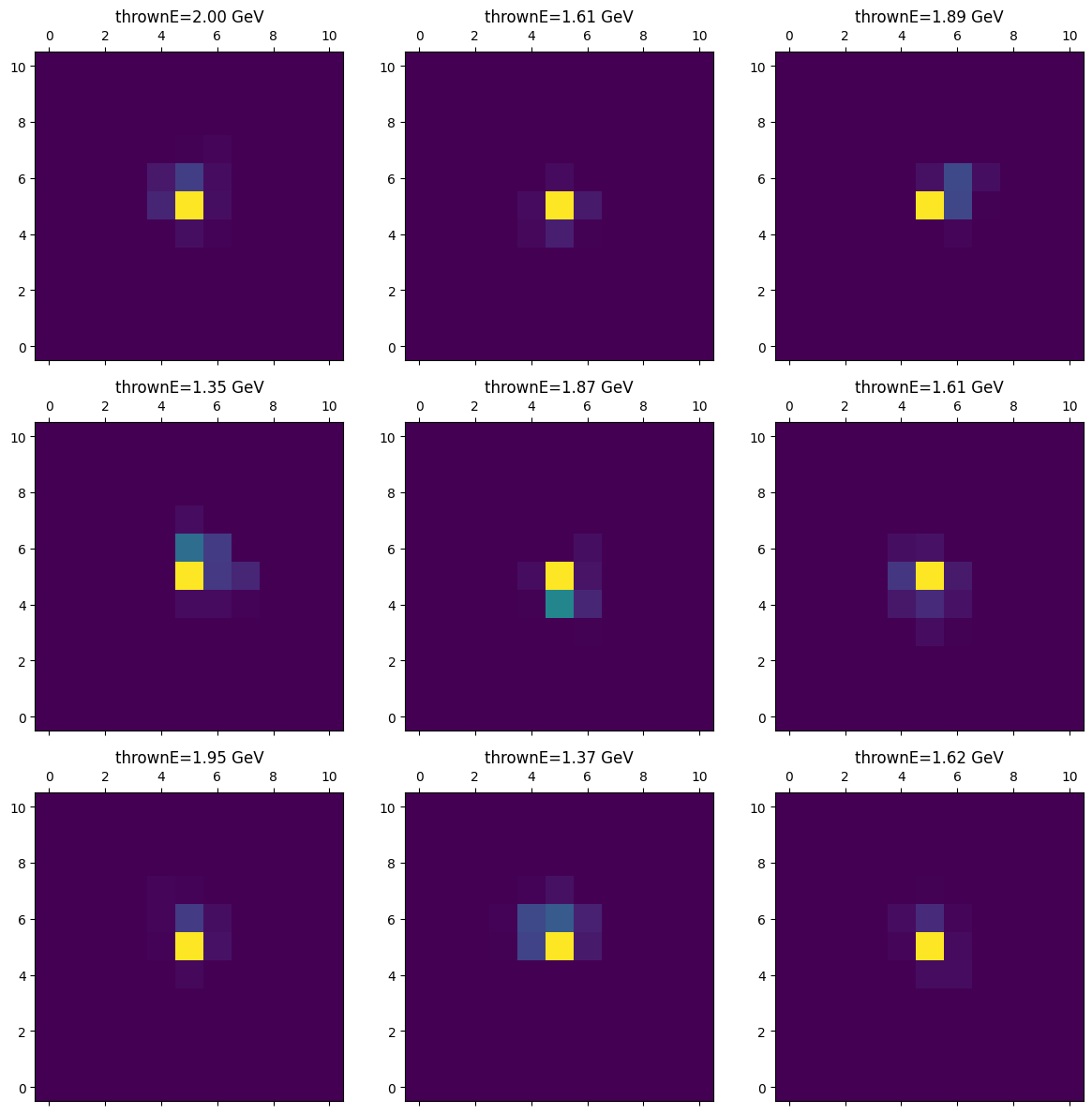
compare_plot(gen_metrics, true_metrics)
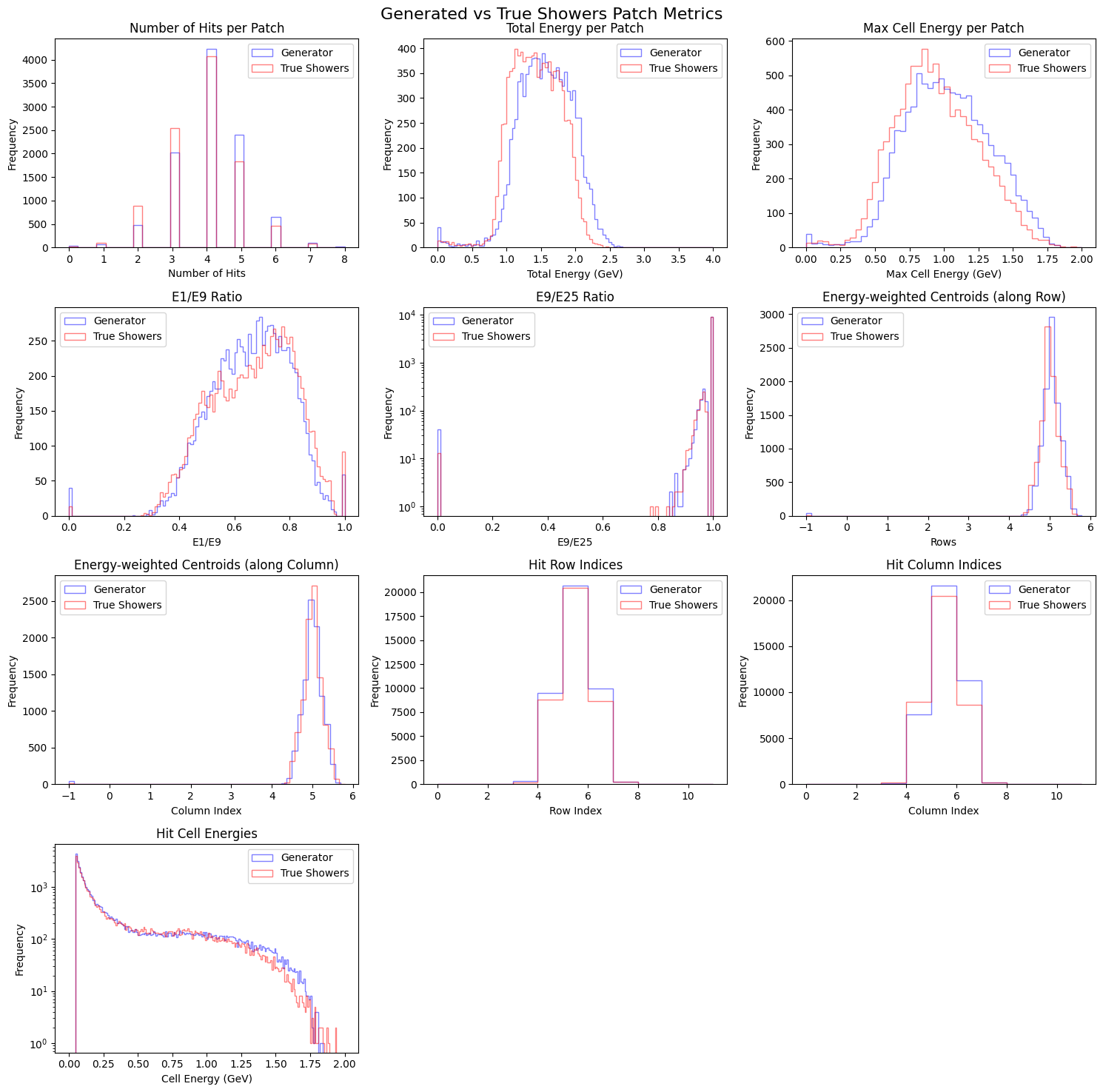
Measuring Fidelity#
# Lets measure distribution fidelity metrics
from scipy.stats import wasserstein_distance
def compute_fidelity_metrics(real_data, generated_data):
metrics = {}
metrics['wasserstein_distance'] = wasserstein_distance(real_data.flatten(), generated_data.flatten())
return metrics
fidelity_metrics = compute_fidelity_metrics(true_patches.numpy(), all_generated)
print("Fidelity Metrics between real and generated patches:")
for k, v in fidelity_metrics.items():
print(f"{k}: {v:.6f}")
# LEts generate some random noise patch and measure fidelity metrics
random_noise = np.random.uniform(low=0.0, high=1.0, size=true_patches.numpy().shape)
random_noise_metrics = compute_fidelity_metrics(true_patches.numpy(), random_noise)
print("Fidelity Metrics between real and random noise patches:")
for k, v in random_noise_metrics.items():
print(f"{k}: {v:.6f}")
Fidelity Metrics between real and generated patches:
wasserstein_distance: 0.001197
Fidelity Metrics between real and random noise patches:
wasserstein_distance: 0.489269
Verifying conditioning#
minthE = 0.5 # This is normalized value
maxthE = 0.6 # This is normalized value
_allthrownE = train_ds.thrownE
indices = np.where((_allthrownE >= minthE) & (_allthrownE < maxthE))[0]
# Lets select true patches
true_patches_sel = torch.from_numpy(train_ds.patches[indices]).unsqueeze(1) # (N, 1, 11, 11)
true_metrics_sel = compute_patch_metrics(true_patches_sel, torch.from_numpy(_allthrownE[indices]))
gen_thrownE_values = np.random.uniform(minthE, maxthE, size = len(indices))
all_generated_sel, all_thrownE_sel = run_inference(len(indices), gen_thrownE_values, G, batch_size=256, inverse_transform=inv_log_global_norm)
gen_metrics_sel = compute_patch_metrics(torch.from_numpy(all_generated_sel), torch.from_numpy(all_thrownE_sel))
compare_plot(gen_metrics_sel, true_metrics_sel)
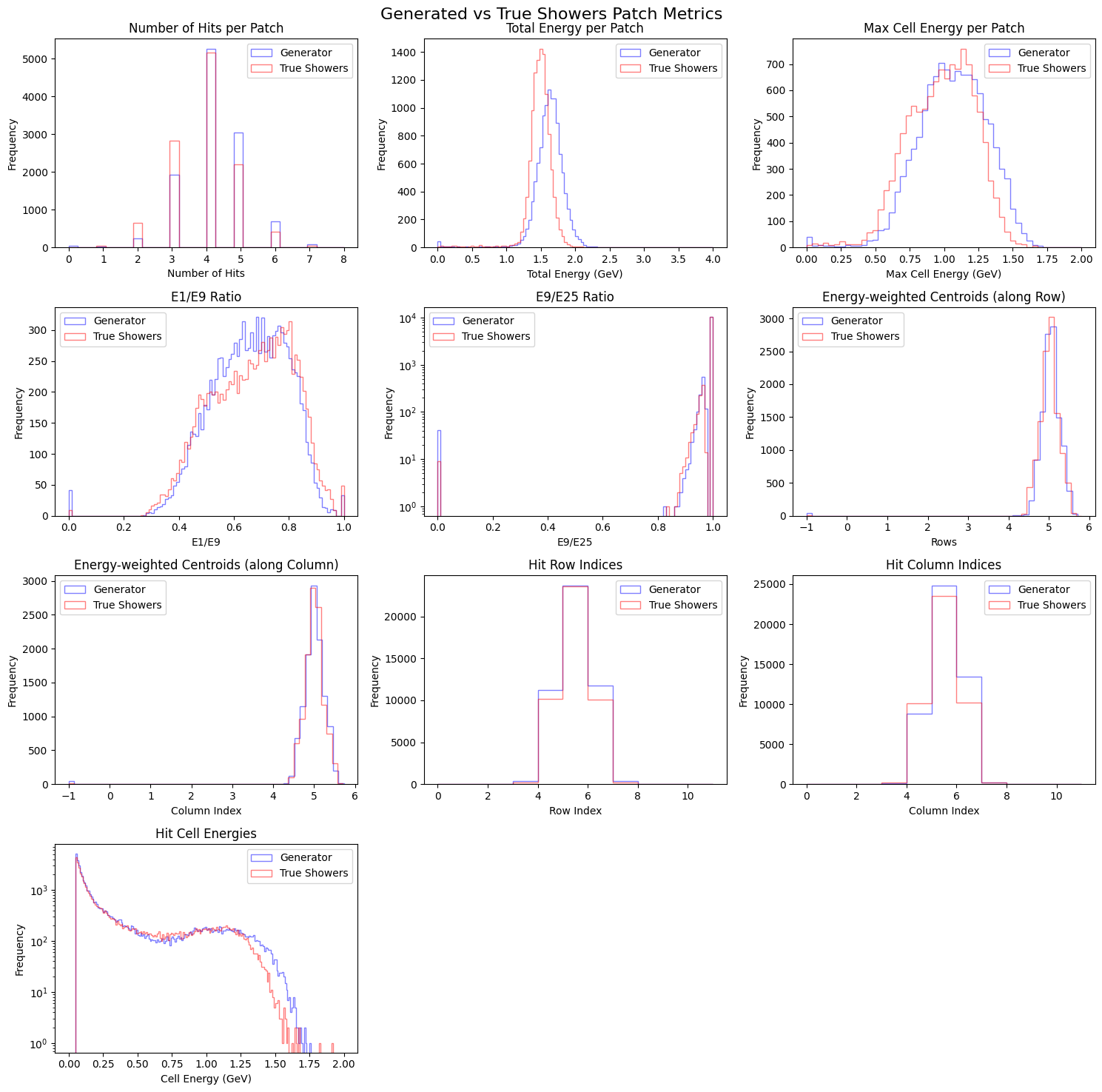
Conclusion#
In this exercise, we successfully demonstrated a conditional Wasserstein GAN with gradient penalty (wGAN-GP) to build a Fast Simulator for calorimeter showers in the GlueX Forward Calorimeter (FCAL). The model was conditioned on the thrown photon energy and trained to generate realistic hit energy maps that reproduce various physics-driven distributions.
The comparison plots show that the generated showers reproduce key observables such as:
Total and maximum cell energy per patch
Energy ratios (E1/E9, E9/E25)
Energy-weighted centroids (row and column)
Hit multiplicities and cell-level energy distributions
This demonstrates that deep generative models can serve as learned surrogates to replace or accelerate full detector simulations — an idea increasingly adopted in nuclear and particle physics (notably, the CaloGAN developed for calorimeter simulations at the LHC).
Drawbacks of GAN-based Approaches#
While GANs offer fast and high-fidelity simulation capabilities, they also come with well-known challenges:
Training Instability:
GAN training is a minimax optimization problem and can suffer from non-convergence or mode collapse.Mode Collapse:
The generator may produce limited diversity, missing some shower morphologies or rare features.Difficulty in Quantitative Evaluation:
Metrics like Inception Score or FID are not always physically meaningful in detector simulation contexts.Hyperparameter Sensitivity:
Performance can vary greatly depending on architecture, batch size, learning rate, and regularization strength.Physics Constraints Not Explicitly Enforced:
The model learns correlations implicitly; enforcing physics priors or conservation laws requires special architectures or loss functions.
Try Next#
Here are a few directions to extend this work:
Expand Kinematic Range:
Train over the full photon energy range (e.g., 0.1–4 GeV) and check model stability and fidelity at high and low ends. A trained model for this purpose is available atgeneratorGAN-FCAL-100MeV-4GeV.safetensors
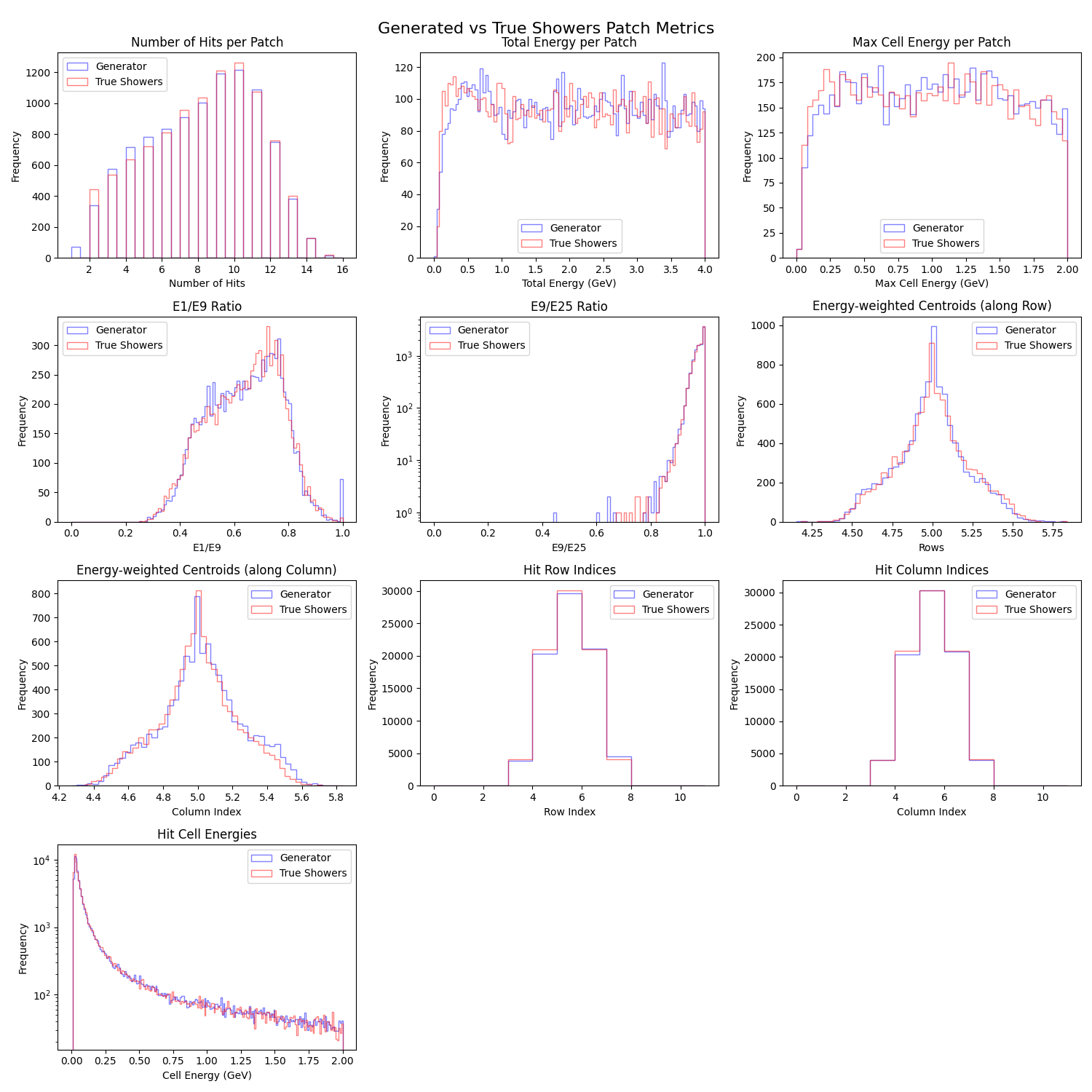
Fig. 6 :caption: Performance of GAN trained on the full photon energy range \([0.1 - 4.0]\) [GeV] with a minimum hit energy threshold of \(0.01\) [GeV].#
Condition on More Features:
Include the photon’s polar \((\theta)\) and azimuthal \((\phi)\) angles as conditioning inputs to model spatial dependence in shower development.
Important
For this, additional data preparation is needed. Refer to Data set preparation on how to create the patched dataset with updated parameters.
Tune Model Hyperparameters:
Experiment with:Number of convolutional layers and filters
Learning rate and optimizer
Gradient penalty coefficient \((\lambda)\)
Batch size and normalization schemes
Evaluate Physics Fidelity:
Compare reconstructed quantities (like \(\pi^{0}\) or \(\omega\) invariant masses) using generated vs. simulated showers.Deploy as a Fast Simulation Module:
Integrate the trained generator into a GlueX simulation pipeline as a drop-in surrogate for Geant4-level calorimeter simulation.
By completing this exercise, you’ve seen how generative AI can be used to accelerate detector simulations while retaining physics fidelity — a powerful tool for next-generation analyses in nuclear and particle physics.
Alternatives and Future Directions#
Several alternative generative approaches address these limitations and are worth exploring:
Variational Autoencoders (VAEs):
Offer stable training and explicit latent-space structure, though sometimes at the cost of sample sharpness.Normalizing Flows:
Provide exact likelihoods and allow density estimation, useful for physically interpretable generation.Diffusion Models:
Recently shown to outperform GANs in both fidelity and stability, with the potential to model fine shower details.Physics-Informed Generative Models:
Incorporate known detector response or conservation laws directly into the architecture or loss function.

